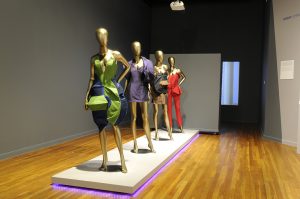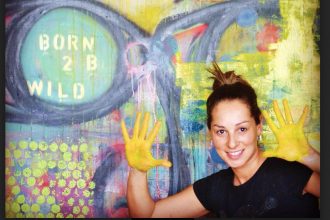Sebastian, un escultor de la calle.

Por Lilia Davis
Sebastián es un escultor Mexicano que realiza impactantes estructuras monumentales que se encuentran y son celebradas tanto en México como en el resto del mundo.
Ha recibido numerosos premios, como en Noruega y Japón, y recientemente ha sido reconocido con el Premio Nacional de Ciencias y Artes 2015 en Bellas Artes en México. Su lenguaje es la geometría transformable. Piensa que la mujer lo es todo, y su sueño es ver sus Nanoesculturas flotando en el espacio.
Todos nos quedamos absortos al ver cómo Sebastián transformaba sus estructuras geométricas con sus propias manos grandes y fuertes, sentado en una mesa frente a nosotros durante su primera exhibición Geometría del Arte y el Tiempo en el Museo Mexic-Arte, en Austin, el pasado abril 2017. Como por arte de magia iban surgiendo pequeñas esculturas en tercera dimensión de colores vivos, amarillo, rojo, verde, morado, moviendo sus manos casi por instinto pero con una gran precisión. Sonreía al finalizar cada una. Su pasión por las matemáticas, ya sea euclidiana o no, era palpable al grado de darnos cuenta de que simple y sencillamente, estábamos enfrente de un genio.
Sebastián
Nacido en Ciudad Camargo, Chihuahua, México, Enrique Carbajal es su nombre de pila. Crece en un entorno en el cual la naturaleza es el foco principal, pero una naturaleza intensa. Los cambios de temperatura, del calor al frío, los vientos fríos, los colores, todo lo abarca y lo absorbe desde niño que más tarde influyen en su arte.
¿Por qué se considera un escultor de la calle?
Así me identifico porque mis esculturas son urbanas y se encuentran en el exterior para ser vistas y apreciadas por todos. Pienso que mi arte es lo más democrático, porque todos, ricos, pobres, jóvenes, ancianos, niños, hombres y mujeres, lo pueden ver. Los museos de exposición son los parques y plazas, de las ciudades del mundo. No tienen horario de apertura o clausura, la entrada es gratuita, y son apreciadas bajo la luz natural.

¿Siempre busca provocar con su obra?
Si la obra no provoca, en la forma positiva o transmite algo, entonces no sorprende, no llama la atención y se convierte en una más del montón. Mi obra es de un lugar profundo, de raíces profundas.
¿Si hiciera un monumento a la mujer, cómo lo haría y qué colores usaría?
Primero que todo quisiera expresar que admiro y siento un gran respeto y reconocimiento a la mujer. La mujer lo es todo. En cuanto a monumentos, tengo un proyecto diseñado como un símbolo a la mujer mexicana, pero no lo he realizado, llamado La Malinche, provocadora del mestizaje. Además, la diosa de la fertilidad. Mujer que conquistó al conquistador. Utilizaría los colores entre el azul turquesa por su belleza y riqueza y el verde esmeralda para simbolizar el poder.
¿Hay alguna mujer que lo haya influenciado para ser la persona que es hoy?
Mi mamá fue fundamental en mi formación como artista. Me enseñó a pintar, me ayudó a pensar, a contar, las matemáticas y a concebir la idea en mi cabeza de que se puede hacer arte. Mi mamá hacía ropa para mujer y me gustaba ayudarle a diseñar y cortar los patrones de ropa. He diseñado una colección de vestidos de alta costura como parte de mi obra y los he presentado en la casa Pierre Cardin en París y en el Desfile de Modas de Mercedes Benz en la ciudad de México. Estos vestidos no son para venderse en masa, aunque se pueden adquirir en la Fundación Sebastián.

¿Por qué utiliza casi siempre el hierro, y cuál es su color favorito?
Es el material que me da la posibilidad de hacer más virtuosismo a nivel monumental, por la estrategia estructural y por la fuerza del hierro y además es el más económico. Además, México es uno de los principales productores de hierro en el mundo. Mi color favorito es el rojo puro.
¿Su sueño para el futuro, Nanoesculturas?
Un día platicaba con alguien que sería increíble ver a mis esculturas flotando en el espacio, un sueño mucho más ambicioso para un futuro más lejano. Ahora estamos un poco cerca. Estamos por firmar un convenio este año para la elaboración de un proyecto de 10 Nanoesculturas, obras de arte de dimensiones nanométricas, en colaboración con el CIC del Instituto Politécnico Nacional (IPN) de México para hacer lanzamientos al espacio con un mensaje. ¡Imagínese! Esto es un ejemplo de que cuando el arte, la ciencia y la tecnología se unen, se convierten en el vehículo para la transformación del futuro.

¿Podría nombrar 3 cosas que usted siempre lleva consigo esenciales en su trabajo?
Un compás, una escuadra y un lápiz. Con eso ya estoy listo para poder trabajar.
¿Por qué dice que la geometría llega a ser emocional y qué lo inspira a seguir adelante?
Para llegar a ese proceso creativo es importante saber un lenguaje. Para mí, ese lenguaje es la geometría. Uno evoca ideas, conceptos, no todo está en la naturaleza. Después llega un momento en que todo está ordenado, muy claro, y el resultado de esa geometría produce una emoción increíble. La vida y la naturaleza misma, me inspiran a seguir adelante.
¿Le tiene miedo a la muerte?
No, no le tengo miedo. He cumplido y logrado cosas muy gratificantes durante mi vida, que me siento satisfecho. Además, pienso que físicamente uno muere, pero la energía se queda. El suspiro humano que creó todo permanecerá para siempre. Así que aquí seguiremos de una manera u otra.
¿Cómo quiere que lo recuerden?
Como mexicano, norteño, creador de estructuras monumentales en todo el mundo. Y recordarles que México es primer mundo en el arte. Sigue las obras de Sebastián en:
Fundación Sebastian (@FsebastianE) | Twitter
Fundacion Sebastian TV – YouTube
Sebastián: A SCULPTOR OF THE STREETS AND TRANSFORMER OF THE FUTURE
By Lilia Davis
Mexican Sculptor Sebastián considers himself a sculptor of the streets and a transformer of the future. His monumental and dynamic structures are found and celebrated both in Mexico as well as in the rest of the world. He has received numerous awards everywhere, countries such as Norway and Japan. Recently he has been recognized by the National Science and Arts Awards 2015 of the Museo Bellas Artes in Mexico. Sebastian’s language is transformable geometry.
“Geometry of Space and Time” Exhibition at Mexic-Arte in Austin
Standing at a table in the museum at a reception for his first exhibition entitled “Geometry of Space and Time” at Mexic-Arte in Austin, this past April, Sebastian mesmerizes the crowd with his hands, working quickly transforming small cubic shapes into astounding sculptures, effortlessly, in blazing colors, yellow, red, green and purple, his fingers moving with precision.
He smiles as he completes one. His passion for mathematics, whether Euclidian or not, was overwhelmingly palpable to the audience, ultimately leading to the unavoidable realization of being in the presence of a genius.
Born in the City of Camargo, Chihuahua, Mexico, Enrique Carbajal is his given name. He grew up in an environment in which nature was a profound influence, but it was an extreme and intense nature. The changes in temperature, from hot to cold, the freezing winds, the colors, he absorbed all of it in his childhood and later it became a major influence on his art.
SCULPTOR OF THE STREETS
He considers himself a sculptor of the streets as his sculptures are urban and are found outside, on the streets and plazas, to be seen and appreciated by all. His work is deeply rooted. He believes art has to provoke in a positive way, to transmit something, otherwise it becomes just another thing in a huge pile of things no one notices.
INFLUENCE OF WOMEN
Sebastián loves, admires and respects women. “Women are everything!” he says. He has a project in mind for a symbol of the Mexican woman, not undertaken it yet, called “La Malinche”, the woman he considers the creator of mestizaje – the blending of cultures. Besides being the Goddess of Fertility, she is the woman that conquered the conqueror. He intends to use colors of turquoise blue because of its beauty and richness and emerald green to symbolize power.
His mother was fundamental to his education as an artist. “She taught me how to plan, to think, to count, to understand mathematics and made me realize that art can be created and that I could do it”, he says. He helped her design patterns for her clothing business.
He designed a group of women’s dresses as part of his art which were presented at Pierre Cardin in Paris, and at the Mercedes Benz Fashion Week in Mexico City. These dresses are true couture, not to be sold commercially as ready to wear, but can be made to order for you at Fundación Sebastián.
IRON IN HIS SCULPTURES
Sebastián most often uses iron in his sculptures because it is the material that provides more virtuosity on a monumental scale, providing structural strength.
And iron is the most economical material, Mexico being one of the main producers of iron in the world. His favorite color is pure red.
Sebastián believes that geometry is emotional. “In order to arrive at a creative process it is important to have a language. For me, that language is geometry,” he says. “One conjures up an idea, concepts, not everything being readily available in nature…. a moment arrives when everything falls into place, things become very clear, and the result is this geometry produces an incredible emotion”.
NANOSCULPTURES
His dream is to see his sculptures floating in outer space, an ambition that is now closer to becoming reality. Sebastián has signed an agreement this year for undertaking a project for 10 “Nanosculptures”- art structures of nanometric dimensions- in collaboration with CIC of the Instituto Nacional Politécnico (IPN) of México to be launched into space with a message. “Can you imagine!” he says. “This is an example of when art, science and technology are united, they become a vehicle for the transformation of the future”.
INSPIRED BY LIFE AND NATURE
Sebastián declares “What keeps me vital is life itself and nature.” He always carries three essential things with him; a compass, a square and a pencil, and with those three, he is ready to work. He confesses that now he is not afraid to die. He has achieved things throughout his life that have satisfied
him. “I believe that one dies physically, but the energy remains.”
SEBASTIÁN wants to be remembered “as a Mexican, a man from the north of Mexico, a norteño, and a creator of monumental sculptures all over the world.” He reminds everyone that Mexico, is a first world country when it comes to art.
Follow Sebastián at:
Fundación Sebastian (@FsebastianE) | Twitter
Fundacion Sebastian TV – YouTube

